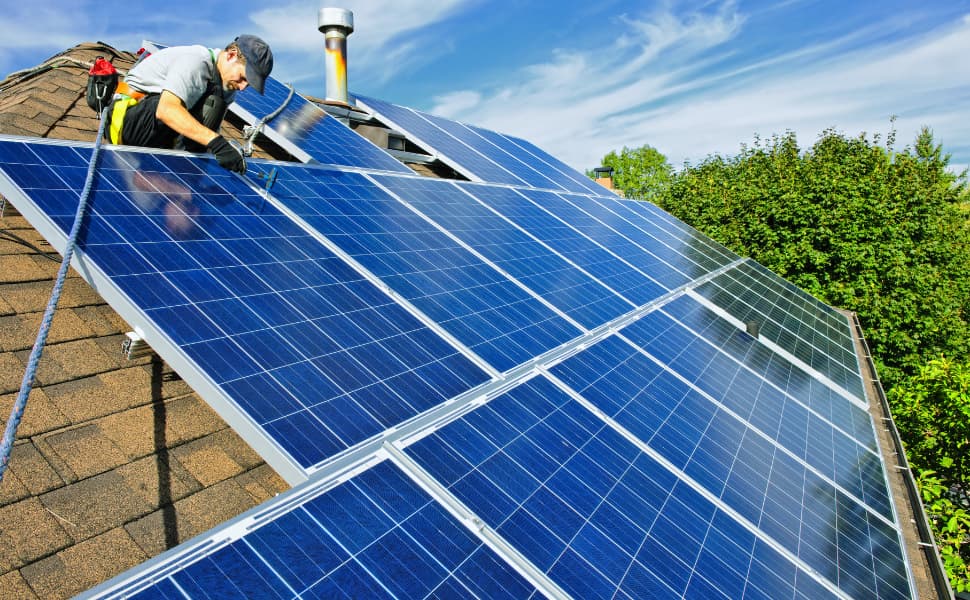Air Source Heat Pumps (ASHPs) are swiftly emerging as an energy-efficient solution in domestic heating, offering homeowners a sustainable means of warmth during the colder months. Operating by extracting heat from the ambient air, ASHPs are a marvel of modern heating technology, capable of providing heat even when external temperatures are notably low.
Yet, while the appeal of ASHPs as standalone systems is evident, there’s a burgeoning interest among homeowners and industry professionals in seamlessly integrating these devices into existing heating arrangements. This surge in attention is driven by the promise of combining traditional heating’s reliability with the green efficiency of ASHPs, laying the groundwork for a more sustainable and cost-effective home heating future.
The Basics of ASHPs
At its core, an Air Source Heat Pump operates on a principle similar to a refrigerator, but in reverse. The system absorbs heat from the outside air using a fluid refrigerant. This absorbed heat then causes the refrigerant to evaporate, transforming it into a gas. Compressors within the ASHP increase the temperature of this gas, which subsequently passes through a heat exchanger. This process transfers the now-amplified heat to a house’s heating and hot water circuits.
It’s worth noting that ASHPs can function efficiently even in cold conditions. Surprisingly to some, these devices are adept at extracting heat from the air even when the temperature drops to as low as -15°C.
Efficiency Ratings and Coefficients of Performance (COP) for ASHPs
One of the key metrics for gauging the performance of an ASHP is the Coefficient of Performance (COP). Simply put, the COP provides insight into the heat pump’s efficiency by comparing the amount of heating or cooling produced to the energy consumed. For example, a COP of 3 indicates that every unit of electricity the ASHP uses, it produces three units of heat.
Modern ASHPs often boast high COP values, ranging between 3 and 4 under optimal conditions. This showcases the device’s prowess in converting electricity into multiple heat units, making them a highly energy-efficient choice for homeowners.
Benefits of Integrating ASHPs
Integrating ASHPs with existing heating systems can lead to significant financial benefits. First and foremost, ASHPs are considerably more efficient than conventional heating systems, especially compared to older, non-condensing boilers. By utilising energy from the environment and multiplying it, ASHPs ensure that multiple units of heat are generated for every unit of electricity used. Over time, this heightened efficiency can translate into tangible savings on monthly heating bills. For homeowners considering long-term investments, these cumulative savings can offset the initial outlay for an ASHP.
The environmental advantage is one of the most compelling reasons to integrate an ASHP into existing heating setups. As the UK pushes towards ambitious net-zero carbon goals, the role of renewable heating technologies becomes paramount. ASHPs, being electricity-driven, have the potential to be powered entirely by renewable energy sources, such as wind or solar power. This means the carbon emissions associated with heating a home can be dramatically reduced, if not completely eradicated. By adopting ASHPs, homeowners can directly and positively impact the environment, contributing to broader sustainability goals.
Estate agents and property experts have observed a trend wherein homes with renewable energy installations, such as ASHPs, command higher market values. Thus, integrating an ASHP can be viewed as an investment that potentially increases the resale value of a property.
Considerations Before Integration
Before integrating an ASHP, it’s crucial to evaluate the compatibility of your existing heating system. Not all systems are conducive to seamless integration. Factors such as the type of radiators, underfloor heating compatibility, and the current boiler’s efficiency are vital in determining how suitable the existing setup is for an ASHP. Typically, systems that operate at lower temperatures are more compatible with ASHPs. Therefore, it’s advisable to thoroughly check your current system’s specifications and understand its working dynamics.
While homeowners may be tempted to assess their systems independently, the nuances and technicalities of heating systems necessitate professional evaluation. A seasoned heating engineer or ASHP specialist can provide an in-depth assessment, identifying potential challenges, efficiency bottlenecks, and optimal integration points. This professional oversight ensures that the integration process is smooth, efficient, and tailored to the property’s specific needs, thereby maximising the benefits of the ASHP.
Integration does not always mean a straightforward addition of an ASHP to the existing setup. Some modifications or upgrades might be required to ensure optimal performance. This could range from upgrading to larger radiators, enhancing insulation, or installing buffer tanks to ensure consistent heat output. It’s also worth noting that older properties with less insulation might need additional measures to maximise the efficiency of the ASHP.
Integrate ASHP with Existing Heating Systems
Step 1:
Before making any decisions, it’s pivotal to understand your property’s current energy consumption and heating requirements. An energy audit comprehensively analyses how and where energy is used in your home. This helps pinpoint areas where energy is wasted, and improvements can be made. Moreover, this audit will clarify how an ASHP can be most effectively integrated into your existing setup.
Step 2:
The capacity and efficiency of an ASHP are crucial determinants of its performance. Choosing an ASHP that aligns with your home’s heating requirements is essential. An oversized unit could increase costs without proportional benefits, while a small unit might not provide adequate heating. Working with professionals, homeowners can determine the correct size and model that offers the best performance-to-cost ratio for their needs.
Step 3:
Depending on your home’s requirements and existing heating system, you might opt for a hybrid system (where the ASHP works in tandem with the existing boiler) or a complete switch to an ASHP. While hybrid systems can offer flexibility and act as a transition point, a complete switch might suit homes with greater energy efficiency and carbon footprint reduction.
Step 4:
Integrating an ASHP might necessitate changes to the existing system. Depending on the ASHP’s operating temperature and your home’s heating requirements, modifications like underfloor heating, larger radiators, or enhanced insulation might be required. Additionally, integrating buffer tanks can help provide consistent heat output for systems aiming for optimal efficiency.
Step 5:
Integrating an ASHP is a technical task requiring precision, expertise, and a keen understanding of heating dynamics. To ensure the system runs efficiently and safely, it’s advisable to rely on professional heat pump installers. Once installed, rigorous testing should be conducted to ascertain the ASHP’s performance, adjust settings if necessary, and ensure the system is primed for optimal operation.
Challenges in Integration
One of the more significant hurdles homeowners face when considering the integration of ASHPs into their existing heating system is the initial cost. While ASHPs can provide substantial long-term savings through reduced energy bills and potential government incentives, the upfront investment required for the heat pump unit, possible system modifications, and professional installation can be considerable. Homeowners must view this investment in terms of long-term benefits and potential returns.
ASHPs consist of an outdoor unit that extracts heat from the ambient air. The placement of this unit is critical for the system’s efficiency. Homeowners must ensure adequate space for the unit to function optimally, away from obstructions and in a location where airflow isn’t restricted. This might pose challenges in properties with limited outdoor space or densely built-up areas. Additionally, considerations regarding noise levels and aesthetics might influence the placement decision.
Once the ASHP is integrated, achieving the highest efficiency requires system fine-tuning. This involves adjusting settings to align with the specific heating needs of the property and the characteristics of the existing heating system. Factors like the flow rate, control settings, and coordination with existing systems (in hybrid setups) all play a role. Ensuring that the system runs at its peak efficiency might require a period of observation, testing, and adjustments, which can be a challenge for those expecting immediate, seamless performance post-installation.
Maintenance Considerations for an Integrated System
Every heating system requires regular attention to operate at its best, and an integrated system with an ASHP is no exception. Homeowners should adopt a routine of periodic checks, ideally every few months, to ensure components such as filters, fans, and evaporator coils are clean and free from obstructions. Blocked or dirty components can reduce efficiency, increasing energy consumption and potentially reducing the system’s lifespan.
Beyond these checks, having the ASHP professionally serviced at least once a year is crucial. A certified technician will inspect the system thoroughly, ensuring that the refrigerant charge is correct, electrical components are safe and functioning correctly, and there are no signs of wear and tear that might cause future issues. This annual service also provides an opportunity to recalibrate the system, ensuring it works optimally with the existing heating setup.
Even after the initial fine-tuning post-integration, maintaining system efficiency is an ongoing endeavour. Regularly monitoring the system’s performance checking the Coefficient of Performance (COP) and Seasonal Performance Factor (SPF), can provide insights into its operation. Any unexpected drop in efficiency could be an early sign of issues that need addressing.
Furthermore, if the property undergoes significant changes, like insulation upgrades or extensions, the system might need re-evaluation and adjustment to cater to the altered heating demands. Ensuring that both the ASHP and the existing heating system are in sync and working efficiently together will not only provide optimal heating comfort but will also prolong the lifespan of the equipment and yield better energy savings in the long run.
The Future of Home Heating
The UK has been assertive in its commitment to a net-zero carbon future, as manifested by numerous policy directives and investment strategies. Central to this vision is the transformation of the domestic heating sector, which traditionally has been a significant source of CO2 emissions due to its reliance on fossil fuels. With buildings accounting for a substantial portion of the UK’s carbon footprint, transitioning to more sustainable heating solutions is paramount.
Air Source Heat Pumps (ASHPs), with their efficient operation and low carbon emissions, are a cornerstone of the UK’s green heating blueprint. Their ability to harness renewable energy from the environment, converting it into heat with minimal electrical input, positions them as a vital tool in the fight against climate change.
Recognising the potential of ASHPs, the UK government has rolled out several incentives to make their adoption more appealing to homeowners. Initiatives such as the Renewable Heat Incentive (RHI) offer financial support to those installing renewable heating systems, including ASHPs, effectively reducing the payback period of such investments.
Further, the Boiler Upgrade Scheme and other localised grants encourage homeowners to switch from traditional boilers to low-carbon heating options. In addition to direct financial incentives, there’s also an ongoing effort to increase awareness about the long-term savings ASHPs can offer in terms of reduced energy bills and potential property value augmentation.
As the nation moves towards its 2050 net-zero target, the focus on greener home heating solutions, with ASHPs at the forefront, is set to intensify. This integration of policy support with technological advancements makes ASHPs not just a feature of modern, sustainable homes but a central figure in the UK’s future heating narrative.
Related Articles
- Air Source Heat Pumps (ASHP) Introduction & Overview
- Top 5 Benefits of Installing an Air Source Heat Pump in Your Home
- The Future of Heating with Air Source Heat Pumps
- Understanding the Coefficient of Performance (CoP) in ASHPs
- Cost Savings with Sir Source Heat Pumps (ASHP) Over Time




